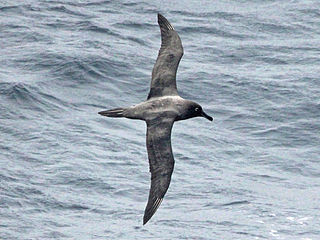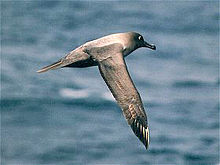
The black-browed albatross, also known as the black-browed mollymawk, is a large seabird of the albatross family Diomedeidae; it is the most widespread and common member of its family.

The Chatham albatross, also known as the Chatham mollymawk or Chatham Island mollymawk, is a medium-sized black-and-white albatross which breeds only on The Pyramid, a large rock stack in the Chatham Islands, New Zealand (Aotearoa). It is sometimes treated as a subspecies of the shy albatross Thalassarche cauta. It is the smallest of the shy albatross group.

The black-footed albatross is a large seabird of the albatross family Diomedeidae from the North Pacific. All but 2.5% of the population is found among the Northwestern Hawaiian Islands. It is one of three species of albatross that range in the northern hemisphere, nesting on isolated tropical islands. Unlike many albatrosses, it is dark plumaged.

The mollymawks are a group of medium-sized albatrosses that form the genus Thalassarche. The name has sometimes been used for the genus Phoebetria as well, but these are usually called sooty albatrosses. They are restricted to the Southern Hemisphere, where they are the most common of the albatrosses. They were long considered to be in the same genus as the great albatrosses, Diomedea, but a study of their mitochondrial DNA showed that they are a monophyletic taxon related to the sooty albatrosses, and they were placed in their own genus.

The Antarctic petrel is a boldly marked dark brown and white petrel, found in Antarctica, most commonly in the Ross and Weddell Seas. They eat Antarctic krill, fish, and small squid. They feed while swimming but can dive from both the surface and the air.

The southern giant petrel, also known as the Antarctic giant petrel, giant fulmar, stinker, and stinkpot, is a large seabird of the southern oceans. Its distribution overlaps broadly with the similar northern giant petrel, though it overall is centered slightly further south. Adults of the two species can be distinguished by the colour of their bill-tip: greenish in the southern and reddish in the northern.

The sooty albatrosses are small albatrosses from the genus Phoebetria. There are two species, the sooty albatross, Phoebetria fusca, and the light-mantled albatross, Phoebetria palpebrata.

The sooty albatross, also known to sailors as the Quaker, is a species of marine bird belonging to the albatross family Diomedeidae. It is a medium-sized albatross that sports a sooty-brown or sooty-black color. It can be found in the southern Atlantic Ocean, the southern Indian Ocean, and the Southern Ocean. This bird scavenges for squid, fish, and carrion. Like other albatrosses, these birds mate for life and return to the same breeding spots every season. A single pair will mate every other year on a variety of islands in the southern Atlantic Ocean and the southern Indian Ocean islands. This bird is an endangered species and conservation efforts are taking place.

The North Pacific albatrosses are large seabirds from the genus Phoebastria in the albatross family. They are the most tropical of the albatrosses, with two species nesting in the Northwestern Hawaiian Islands, one on sub-tropical islands south of Japan, and one nesting on the equator.

The Campbell albatross or Campbell mollymawk, is a medium-sized mollymawk in the albatross family. It breeds only on Campbell Island and the associated islet of Jeanette Marie, in a small New Zealand island group in the South Pacific. It is sometimes considered a subspecies of the black-browed albatross. It is a medium-sized black and white albatross with a pale yellow iris.

The Indian yellow-nosed albatross is a member of the albatross family, and is the smallest of the mollymawks. In 2004, BirdLife International split this species from the Atlantic yellow-nosed albatross; however Clements has not split it yet, and the SACC has not either, but recognises the need for a proposal.

The northern royal albatross or toroa, is a large seabird in the albatross family. It was split from the closely related southern royal albatross as recently as 1998, though not all scientists support that conclusion and some consider both of them to be subspecies of the royal albatross.

The Cape petrel, also called the Cape pigeon, pintado petrel, or Cape fulmar, is a common seabird of the Southern Ocean from the family Procellariidae. It is the only member of the genus Daption, and is allied to the fulmarine petrels, and the giant petrels. They are extremely common seabirds with an estimated population of around 2 million.

The southern royal albatross or toroa, is a large seabird from the albatross family. At an average wingspan of above 3 m (9.8 ft), it is one of the two largest species of albatross, together with the wandering albatross. Recent studies indicate that the southern royal albatross may, on average, be somewhat larger than the wandering albatross in mass and have a similar wingspan, although other sources indicate roughly similar size for the two species and the wandering species may have a larger average wingspan in some colonies.

The Tristan albatross is a large seabird from the albatross family. One of the great albatrosses of the genus Diomedea, it was only widely recognised as a full species in 1998.

The fairy prion is a small seabird with the standard prion plumage of blue-grey upperparts with a prominent dark "M" marking and white underneath. The sexes are alike. It is a small prion which frequents the low subantarctic and subtropic seas.

The white-chinned petrel also known as the Cape hen and shoemaker, is a large shearwater in the family Procellariidae. It ranges around the Southern Ocean as far north as southern Australia, Peru and Namibia, and breeds colonially on scattered islands. The white-chinned petrel was formerly considered to be conspecific with the spectacled petrel.

The Antarctic prion also known as the dove prion, or totorore in Māori, is the largest of the prions, a genus of small petrels of the Southern Ocean.

Salvin's prion, also known as the medium-billed prion, is a species of seabird in the petrel family Procellariidae.























